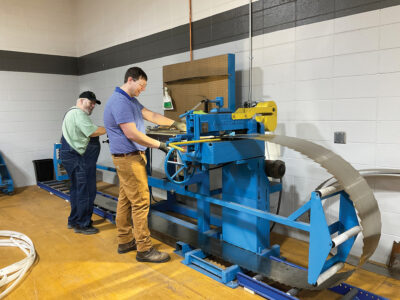The demand and level of activity for Softwood lumber providers in the Southeast depends on what type of product they sell and to whom they sell it.
One wholesaler in Mississippi sells to a broad geographic area, and he said “Our business is extraordinarily good. I’d say it’s about the same as several months ago.” He sells lumber to customers on a contract basis with fixed prices. “Our customers didn’t see a lot of up and down in pricing when it went up and when it came down.” He said the drop in prices for Pine, dimension lumber and timbers is “no secret to anybody.” “What we’re seeing,” he said, “is the market has given up 80 percent or more from the very highest prices. It varies by item. Dimension lumber prices have fallen 75 to 80 percent. What that’s done to the market is, people stopped buying for a period of time to take advantage of lower prices. The prices seem to have begun to find a bottom level. But that remains to be seen if prices will go back up. The overall demand is good but it’s not enough to absorb all of the production in Pine.
“It’s been hard all year to provide for our customers,” he said of the lumber shortages. “That has flipped now. Some of those Pine products that were hard to get are readily available, and prices have collapsed. But the demand from our customers didn’t wane when products were hard to get and prices were high. We haven’t seen any difference in the demand from our customers.”
He looked back on the period of time when prices were sky-high and product was scarce. “The whole COVID environment led to mills having difficulty running at full production, from April of 2020 till 2021. Demand for Softwood from home centers for DIY projects put extraordinarily unprecedented demand on home centers and mom and pop retailers. These stores didn’t have enough wood. The mills tried to chase that demand well into this year, but couldn’t catch up with demand. Also, home building has been strong. There was demand from that sector as well. In the last couple of months, the Pine manufacturers have been able to catch up with demand and then rapidly exceed it. Mills had 30-day order files; now they have 30-day surpluses. They have to sell it, and the only way to do that is lowering the price. Not having enough people in the mills to run at optimum production, combined with high demand, led to high prices. Now we’re back to normal.”
This wholesale representative sells Southern Yellow Pine, in low grades, dimension and timbers to end use manufacturers. His customers’ business is strong, he said.
Asked if transportation is an issue, he replied, “No. Our transportation issues have gotten much better. It’s less expensive and they’re more available. There is less transportation demand from home centers because the market has collapsed. Seasonally, we are toward the end of the optimum building season, especially in the Midwest and Northeast.”
The story is different for an exporter in Louisiana, who deals in Southern Yellow Pine, even as his company sells many other species. “Overall the export markets are quiet,” he stated. “Business is off about 50 percent. That’s over the last four weeks. A lot of that is due to Europeans being on vacation, a slow time for business in the Caribbean due to hot and rainy weather, parts of Asia being in the grips of COVID and some American lumber being overvalued with a price correction coming.”
Asked if Softwood lumber prices have crashed, he replied, “Yes and no. Commodity Softwood Yellow Pine S4S at big box stores, the prices eroded by 50 to 70 percent. The prices got very near to pre-COVID levels. Now prices have started to rebound modestly. They’re behaving as they would have behaved pre-COVID. The price of 1-inch dressed Softwood had more than doubled in the COVID era, and its prices move more slowly. It’s in the process of collapsing. The prices will slowly erode over the next 12 to 15 weeks, if I had to guess.”
Compared to a few months earlier, his market, he said, is “much worse, due to the collapse of prices and the lack of buyer confidence in the market. My whole division in the last four weeks has sold less than we would sell, from a dollar standpoint, in some individual weeks six months ago. We’re still busy, but we’re having to fight hard for orders.
“We tend to sell to manufacturers and stocking distributors mostly worldwide,” he remarked. Business for his customers is tending to be slow, he said.
“Transportation is still pretty tough from an ocean freight standpoint,” he added. “Bookings to a lot of countries are five to seven weeks out. There are lanes where we’ve taken a general rate increase almost every month since December 2020. So, shipping to some places has doubled and in some places nearly tripled.” As for inland trucking, it is more difficult on the East Coast, he observed.
In Alabama, a distribution yard representative, who sells engineered wood, stated, “Business has not slowed down, but supply is low. If I had product, I could sell it.”
Since several months ago, “Nothing’s changed. I still don’t have much to sell. Prices are still high for engineered wood. Prices have plummeted for the rest of my company.”
She sells her products to building supply stores and big box stores. Their business is the same as hers: “If they had it they could sell it,” she remarked. “I think part of the country slowed down in building for a time, but I don’t think anybody’s lacking any work right now.”
Transportation is such that it slows down when she gets the product, “when I do get product,” she stated.









